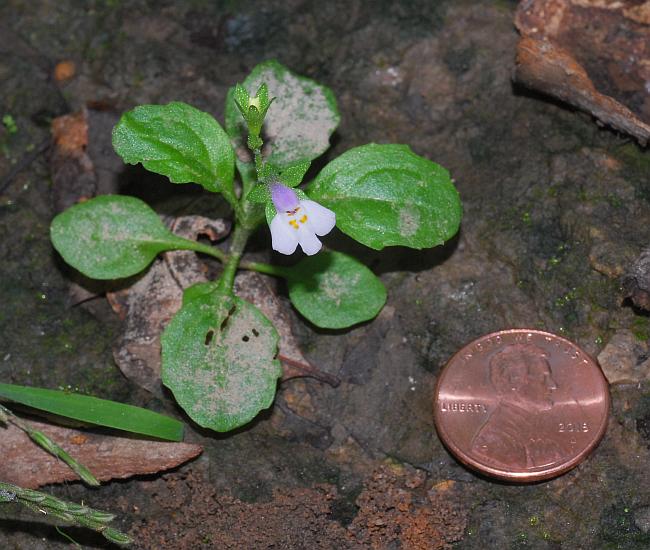Mazus pumilus (Burm. f.) Steenis
Mazus

Introduced
CC = *
CW = 3
MOC = 4
© SRTurner
Mazus pumilus (Burm. f.) SteenisMazus | |
 |
Introduced CC = * CW = 3 MOC = 4 |
© SRTurner |
|
Family - Phrymaceae Habit - Annual or possibly short-lived perennial forb, usually with a slender taproot.
Stems - Loosely ascending to ascending, to 20 cm (including the inflorescence), 1 to several from the base, individually usually unbranched or few-branched, bluntly 4-angled, the angles slightly ridged, sparsely pubescent with short, curved hairs, also glandular toward the tips (and inflorescence axes).
Leaves - Basal and opposite, usually becoming alternate toward the stem tip, simple, petiolate below, sessile above. Petioles indistinct and winged. Blades 1-4 cm long, those of the basal leaves noticeably larger and usually spatulate, tapered at the base, rounded at the tip, those of the stem leaves shorter, oblong to elliptic or somewhat spatulate, variously tapered or truncate at the base, sometimes somewhat clasping the stem, rounded to bluntly pointed at the tip, the margins of both types irregularly wavy to bluntly toothed, sometimes ciliate at the base, the surfaces glabrous to moderately short-hairy.
Inflorescence - Elongate, open, terminal racemes of 3-15 alternate flowers, each subtended by an inconspicuous, linear bract 1-3 mm long, the stalks 3-10 mm long at flowering, elongating to 7-16 mm at fruiting, mostly glabrous but glandular-strigose on the adaxial surface in one line, expanded near the apex.. Inflorescence typically occupying most of the stems.
Flowers - Calyces 3-5 mm long at flowering, becoming enlarged to 5-9 mm at fruiting, actinomorphic, bell-shaped, the 5 lobes similar in size to the tube, elliptic to ovate-elliptic, short-hairy, somewhat angled or thickened along the midrib, somewhat spreading at flowering and fruiting, sharply pointed. Corollas bilabiate, 7-10 mm long, lavender to purple and somewhat glandular on the outer surface, the upper lip somewhat hooded, shallowly notched at the tip, lavender to purple on the inner surface, the lower lip with the lateral lobes much larger than the middle lobe, white or very pale lavender on the inner surface, the base of the lip with a pair of prominent, rounded, longitudinal ridges, these with a series of yellow spots. Stamens in two pairs, included, adnate near the middle of the corolla tube, each pair converging and the anthers connate. Filaments curved, white, glabrous, 4 mm long. Anthers yellow, 1 mm broad. style lilac,s 6 mm long, glabrous. Stigma compressed. Ovaries superior, globose, appearing 2-carpellate (with a pair of sutures on opposing sides), containing numerous ovules. Placentation axile.
Fruits - Capsules, 3.0-4.5 mm long, globose, glabrous. Seeds 0.3-0.4 mm long, oblong-ellipsoid to narrowly ellipsoid, the surface appearing pebbled or with a fine network of ridges, brown.
Flowering - May - October. Habitat - Streambanks, lawns, bottomland forests, roadsides, cultivated fields. Origin - Native to eastern Asia. Lookalikes - None. Other info. - This little introduced species is presently rare in Missouri. Its range elsewhere is scattered in mostly the southeastern quadrant of the continental U.S., with disjunct populations in the northwestern and northeastern regions of the country. The plant is generally small and inconspicuous, but the small flowers are quite striking up close, and the plant is sometimes grown as a rock garden ornamental. It grows easily from seed and many seeds are produced with each fruit. Many flying insects are attracted to the flowers. The plant's flowering season in Missouri is not well defined, with flowering collections ranging from early May through mid October. Descriptions of this plant as "invasive" seem overwrought, at least in Missouri. Photographs taken by Tom's Creek, NC., 4-20-03 (DETenaglia); also at Lower Meramec Park, St. Louis County, MO, 9-17-2018; Castlewood State Park, St. Louis County, MO, 10-8-2021; and Greenville Recreation Area, Wayne County, MO, 4-8-2024 (SRTurner). |